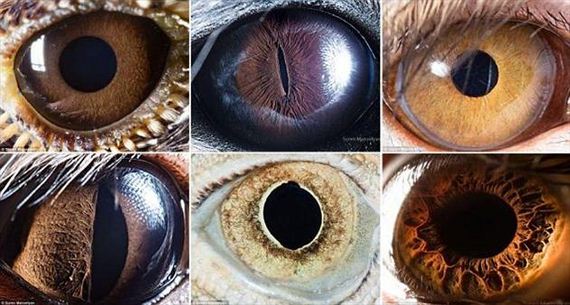
Photographer latest collection contains extreme close-up photos of various animal eyes, including humans, rabbits, lemurs, chimps, tigers and more
Llama
We know what you’re thinking, what on earth is that?! It might look like a very foreign or strange planet, but that is actually a close-up of a llama’s eye!
The wavy patterns are called “iridic granules” and they act as horizontal filters. These filters limit glare and reduce eye strain in bright light – Kind of like a built-in pair of sunglasses! These iridic granules also tighten and close over the pupil to limit the amount of light received while still focusing.
Llamas, interestingly enough, have three eyelids, as well as other more common features of the eye such as a cornea, a sclera, an iris and pupil, a lens, a retina and an optic disk. Llamas have an oval-shaped pupil, like some other animal species, and due to their small head sizes, their eyes have a tendency to look quite large.
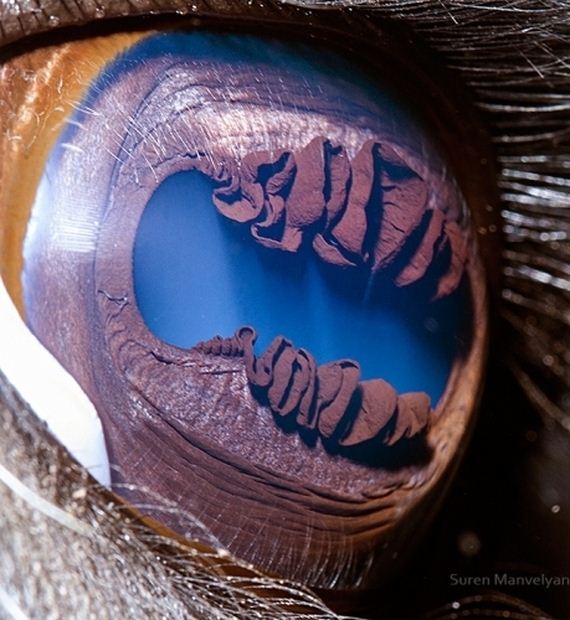
Caiman
Caimans are very similar to alligators, and the both species share similarly-looking pupils! They are a smaller breed than most crocodiles and alligators, and are commonly found in Central and South America. Some species of Caiman are also found in southern Florida.
Caimans have long, thick, tapering tails and elongated snouts. Judging by this photograph, they also have very unique pupils. You may notice the zig-zag markings on they eye, as well as the typically greenish-yellow coloring. Caiman eyes have a layer called tapetum behind their retina, containing crystals that reflect light and make night vision possible.
Did you know that the caiman eye at night not only produces an ‘eyeshine’ but it’s also iridescent, which means the color changes with the angle of the light source? Neither did we! Guess that’s what makes the animal kingdom a never-ending surprise…
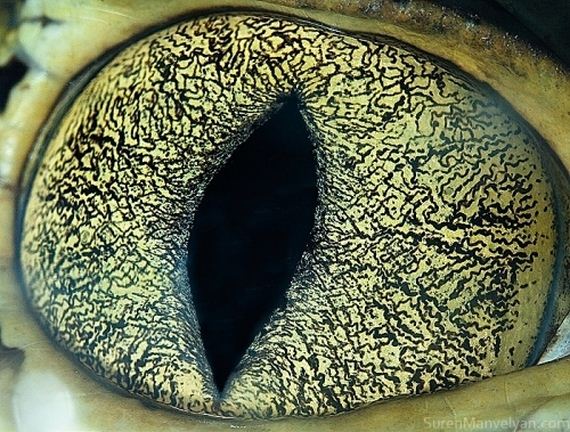
Siberian Husky
The eyes of a Siberian Husky are ice-blue, dark blue, amber, or brown. In some individual dogs, one eye may be brown and the other blue, or pupils may even be a combination of both. Husky’s have almond-shaped eyes, and they are known for having the most beautiful eyes of all the different species of dogs.
The Siberian Husky originated in north-eastern Siberia, and this is why the species has such a thick coat of fur. Huskies were originally sent to Canada and Alaska as working dogs, however they soon began to be chosen as popular domestic pets because of their gentle, but resilient nature. We think looking into this pupil is like looking into a cracked frozen lake. Absolutely brilliant coloring!
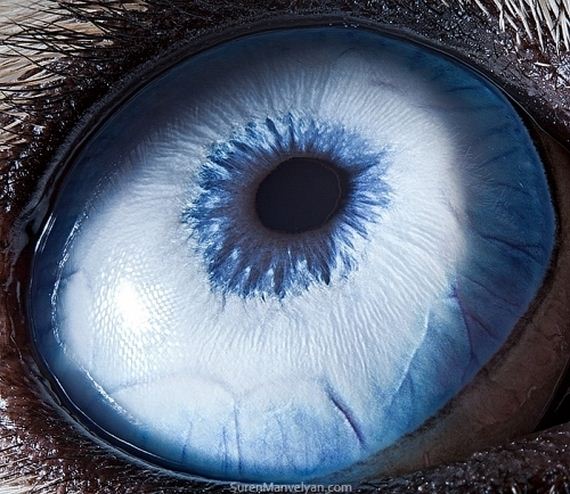
Chimpanzee
You might think you know a lot about everyone’s favorite monkey, but just take a look at those Chimpanzee eyes – They’re magical! The two chimpanzee species are the closest living relatives to humans, and this is why their pupils look so similar to our own!
Chimpanzees certainly are clever, and they can even walk upright on two legs when carrying objects with their hands and arms. Chimpanzees have also learnt how to make tools and use them to collect food. The species use vocalizations, hand gestures, and facial expressions to interact with one another, and even so much as a glimpse with those astonishing eyes of theirs can communicate a whole message to other members of their group.
Although the pupil of a chimpanzee is quite similar to those of a human, you may notice the coloring to be slightly different than our usual brown, blue, grey and green.
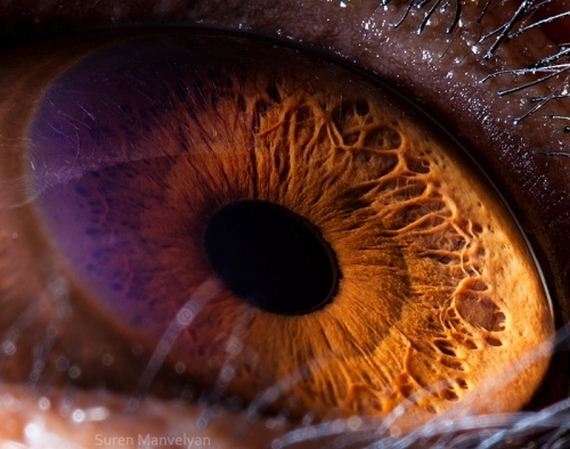
Albino Tiger Python
Did you know that the Albino Tiger Python is the world’s longest reptile species? They can grow up to around seven meters long – Yikes! This species is found predominantly in Southeast Asia.
As you can see, their pupil has an unusual marbled pattern and is very circular in shape. Although their light coloring may seem like a disadvantage, it actually works well to help them fit into their natural jungle environment. If you’re a little faint-hearted when it comes to snakes, then perhaps it’s best you don’t read the next bit! Albino Tiger Pythons have been known to cause quite a few human deaths. Although some accounts have not been proven, it is believed that this species of snake has swallowed human beings whole – Crazy!
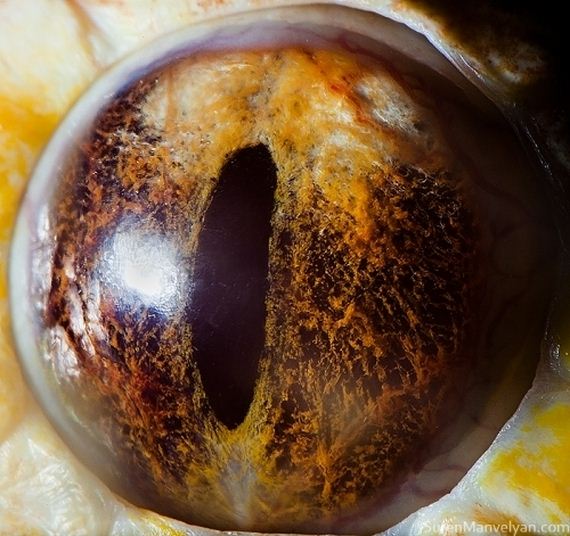
Stingray
Stingrays are found in tropical and subtropical marine waters throughout the world. There are eight different families of stingray, and they are categorized depending on their appearance and habitat.
Stingrays often hide from predators among the sand, and one of the reasons they can do this is because of their flat shape. Stingrays cannot actually see their prey, and this is because their eyes are located on top of their body, and their mouth is located on the underside of their body. This means stingrays must use other senses, such as smell and electroreceptors to locate their food.
An interesting fact about stingrays is that the females are able to store sperm and not give birth until they decide the timing is right. Looking at this close-up photograph of a stingray’s pupil, it reminds us of the eyes of other marine life such as fish.
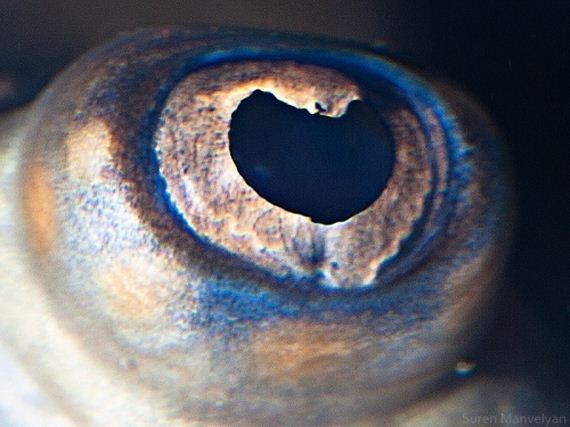
Lark
A Lark is a small- to medium-sized bird, commonly found in parts of Australia and in some parts of North America. They often live in drier habitats, and unlike most birds, they build their nests close to, or on the ground. Larks are even recognized as pets in China!
The birds are even taught to mimic the voice of other birds and animals. Looking at this close-up of their pupil, you will notice that they have quite a fierce-looking eye. We wouldn’t want to get on a Lark’s bad side!
The Lark might have a dull brown appearance, however this serves to camouflage them well from their predators.
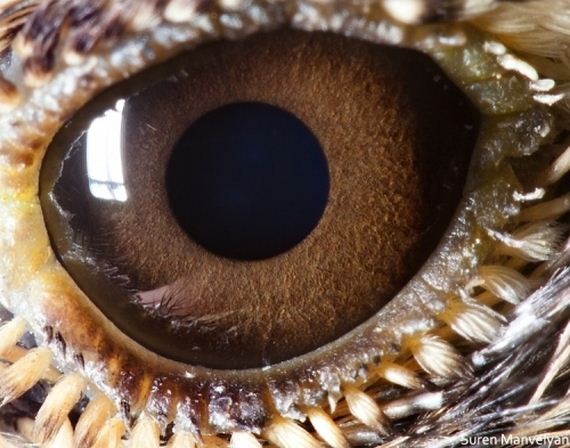
Iguana
The Iguana is a species of lizard native to tropical areas of Mexico, Central America, Fiji, Tonga and islands in the Caribbean. Did you know that Iguanas have a third eye? Not to be confused with an eyeball of course, but the species’ ‘third eye’ is known as the parietal eye, and it is visible as a pale scale on the top of the head.
The Iguana might have a pretty scary-looking eye, but they also have fantastic vision. Iguanas can see shapes, shadows, colors, and movement clearly even at long distances. They are able to use their excellent vision to make their way through crowded forests in search of hard-to-find food.
Iguanas also use eye signals to communicate with other Iguanas – Impressive, right? Another interesting fact about the Iguana is that their eardrum is located directly behind the eye.
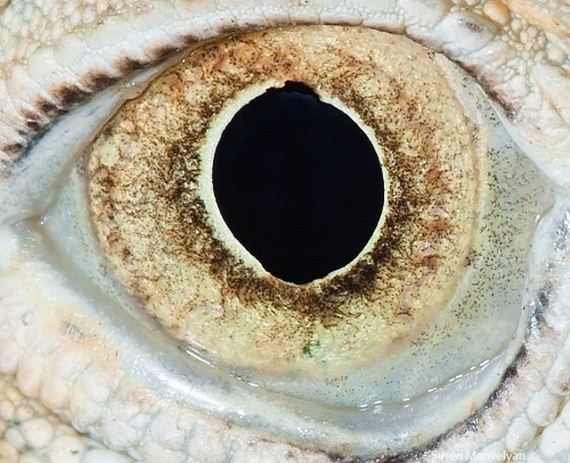
Horse
Looking at the close-up of a horse’s pupil kind of reminds us of looking at a strange planet with a lake in the middle of it….Horses do have rather beautiful eyes though, and did you know that the equine eye is the largest of any land mammal? Neither did we!
The iris of a horse is usually dark brown in color, however it can also be a variety of colors, including blue, hazel, amber, and green. Horses are lateral-eyed, meaning their eyes are positioned on the sides of their heads. This allows them to see a range of vision of more than 350°. Horses are not color blind, but they do have dichromatic vision. This means that similarly to red-green color blindness in humans, red and related colors appear more like green.
A visual difference between horses and humans is that horses are less able to adjust to sudden changes of light than humans are, such as when moving from a bright day into a dark sheltered area.
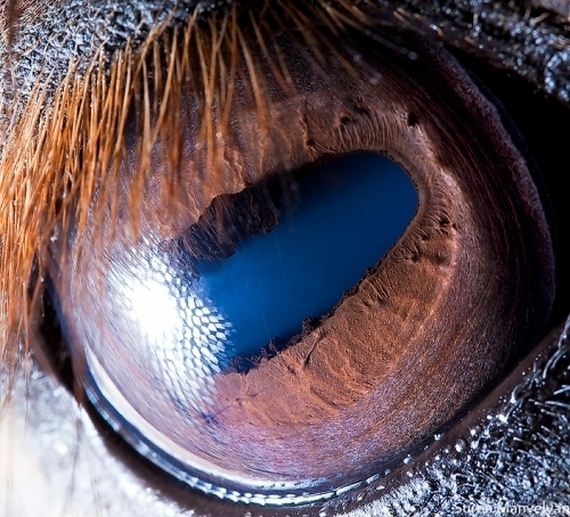
Guinea Pig
We hate to say it – Guinea pigs might be cute, but they certainly do have one freaky eyeball! Did you know that baby guinea pigs open their eyes in their mother’s womb 14 days before birth?
Despite their name, guinea pigs are not part of the pig family, nor are they from Guinea. This species makes a great pet, especially because of their gentle nature and the fact that they are quite easy to care for.
An unusual fact about this animal is that when in the wild, they behave very much like cows. Before you scratch your head in confusion, let us explain! Wild guinea pigs live in small groups and move together in herds. They eat grass and other vegetation, and are unable to store food like some other wild animals. Wild guinea pigs also tend to be most active during the darker hours, and this is because it is during the night that they are harder to spot by predators.

Fish
Yikes! If you look at this fish’s eye from the side, it almost looks like some sort of space dome. Fish eyes are actually quite similar to the eyes of birds and mammals, however fish eyes have more of a spherical lens.
Most fish have colored vision, and some can even see ultraviolet or polarized light. A major difference between the eyes of fish and the eyes of humans is that fish normally adjust focus by moving the lens closer to or further from the retina. Imagine if us humans had our very own built-in zooming lens!
A fish’s eyes will adjust to their environment. For example, if a fish dwells on the ocean floor, its eyes will have adjusted to the darker environment. Most fish species seem to have a fixed pupil size, which means that unlike humans and a lot of other animals, it doesn’t adjust to light changes throughout the day.
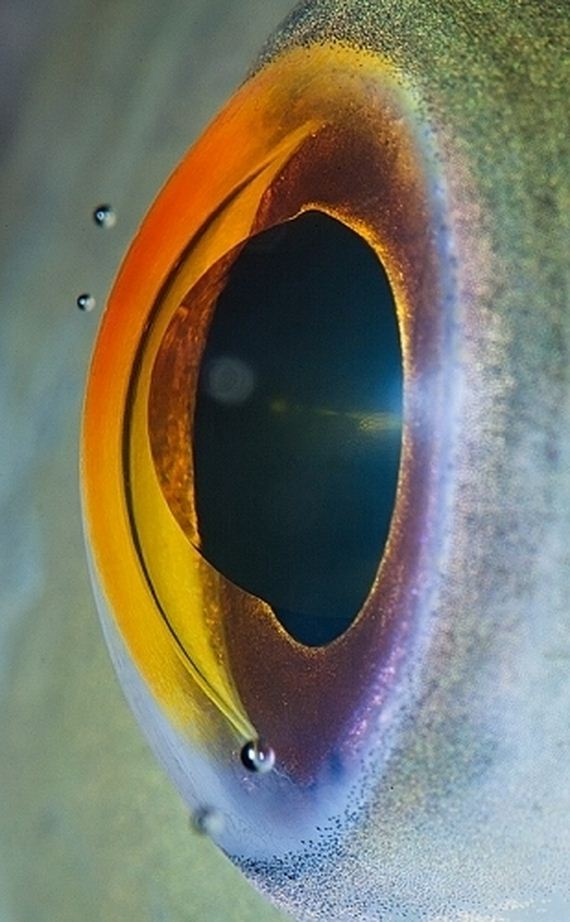
Cow
There are a number of differences between a cow’s eyes and a human’s eye, and this is evident from looking at this picture! Who knew a cow’s eye could be so freaky close-up?
Cows eyes are actually oval-shaped, and humans’ eyes are circular. A similarity between cow eyes and human eyes is that both have an optic nerve which connects to the brain allowing us to see. Did you know that cows have to move their head up and down and from side to side in order to see in these directions? This is because, unlike human eyes, cows only have four muscles which operate within their eyes.
Humans, on the other hand, have six of these muscles, allowing us to move our eyeball around in its socket in order to see in a range of directions.
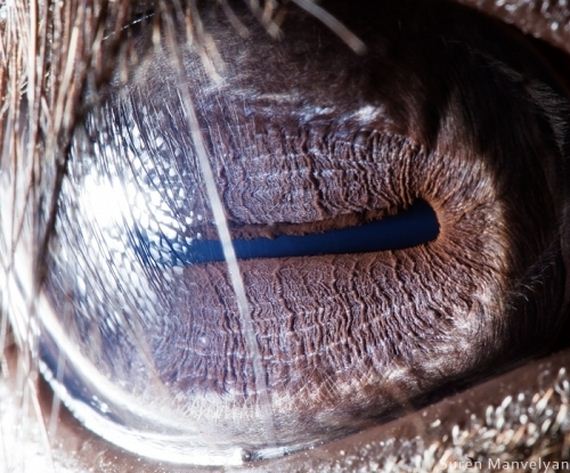
British Shorthair Cat
Did you know that the British Shorthair is the most popular breed of domestic cat? Their eyes are large, round, widely set, and can be a variety of colors, but the copper or gold eyes of the breed are the best known.
British Shorthairs are usually indoor-only pets, and they have a very friendly demeaner. They are also well-known for their round and chubby faces, as well as their beautiful and silky fur. British Shorthairs became very popular around the world with the emergence of the “I Can Has Cheezburger?” cat – The most famous British Shorthair of all!
Cats’ eyes have a tapetum lucidum, which is a reflective layer behind the retina that sends light that passes through the retina back into the eye. Cats can see some colors, and can even tell the difference between red, blue and yellow lights, as well as between red and green lights. So next time you hear that cats are color blind, this isn’t the case! Did you know that cats are able to distinguish between blues and violets better than between colors near the red end of the spectrum? Fascinating, right!
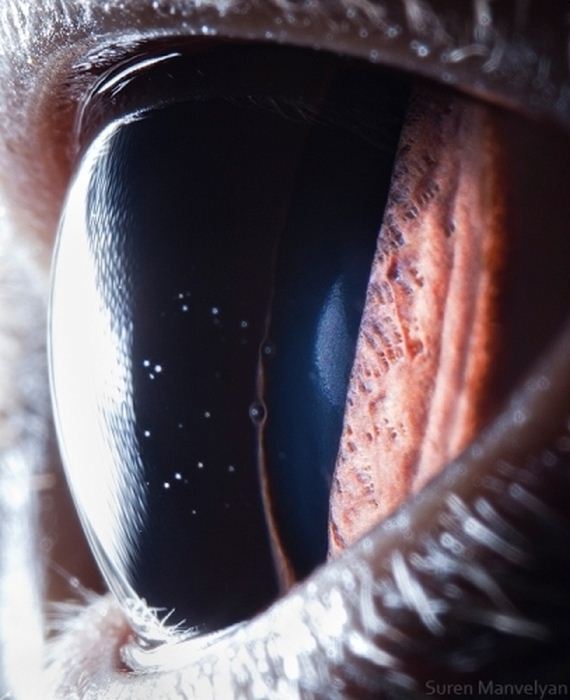
Blue-Yellow Macaw Parrot
Also known as the Blue-and-Gold Macaw, the Blue-Yellow Macaw Parrot is commonly found in forests and woodlands in South America. The beautiful bird is well-known for its colorful blue top parts and vibrant yellow under parts. You may have also noticed these parrots are stocked in some pet stores, and this is because of their amazing colorings, as well as their ability to talk and to bond with humans.
This species is also well-known for its loud shrieks and mischievous behavior. When the parrot is born, it will have very dark eyes. As the parrot matures, however, its eyes will gradually begin to turn lighter yellow or grey over time. Judging from the eye shown here, it is evident that the parrot was of mature age.
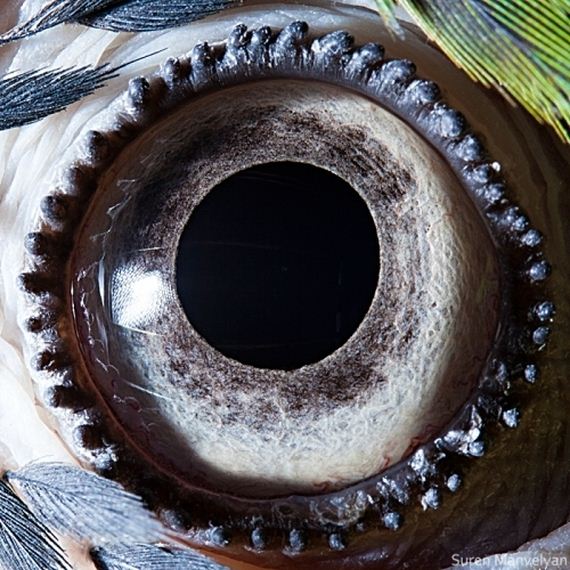
Blue Crayfish
The blue crayfish is a blue colored morph of the common brown papershell crayfish. It is the lack of a gene that causes them to be blue. The eye of the blue crayfish seems to protrude outward from its head, like most crustaceans.
We could not help but notice the fly-appearance of this species’ eye! It could even be mistaken for a microphone when it has been magnified at this rate!
This unusual underwater animal is commonly found in parts of Florida. Due to the species’ bright blue color, they find it harder to camouflage, and therefore cannot hide or protect themselves from predators. Blue crayfish can also be kept as pets, and you will commonly find them in aquariums. The species can grow to be as large as 15cm in length.
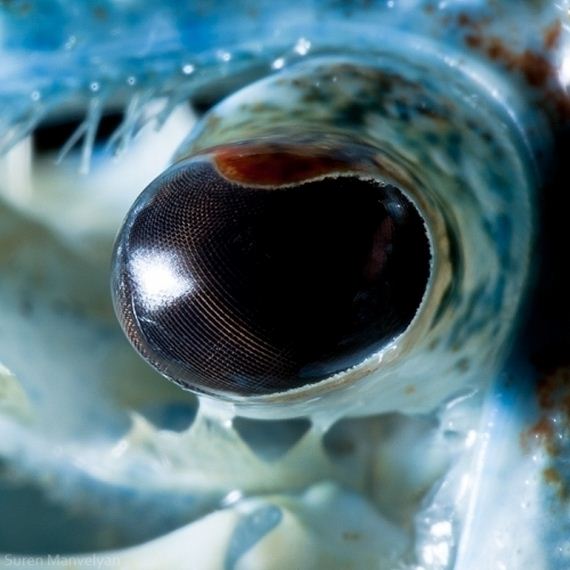
 Barnorama All Fun In The Barn
Barnorama All Fun In The Barn